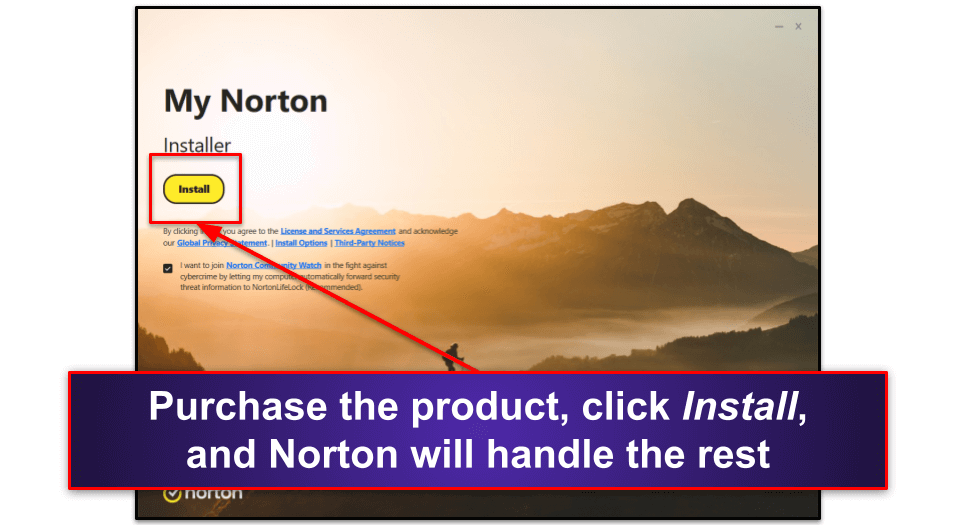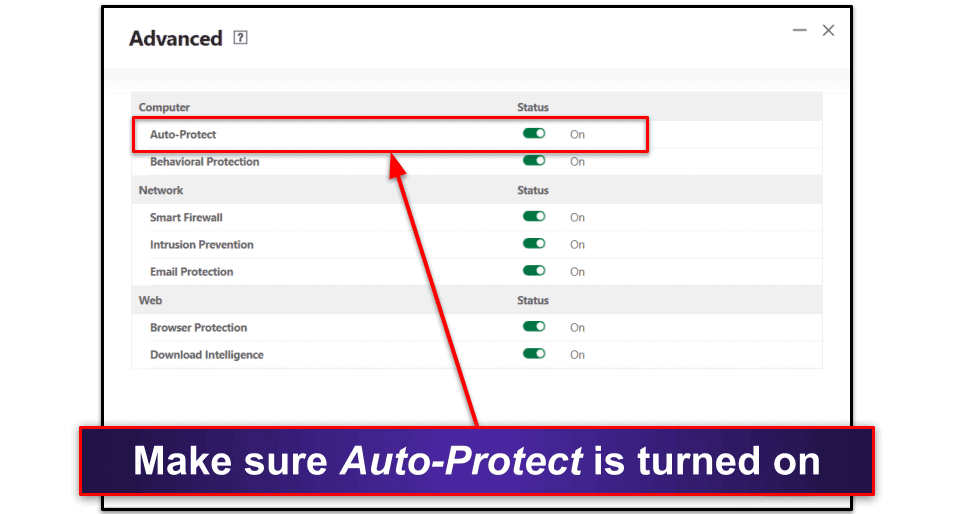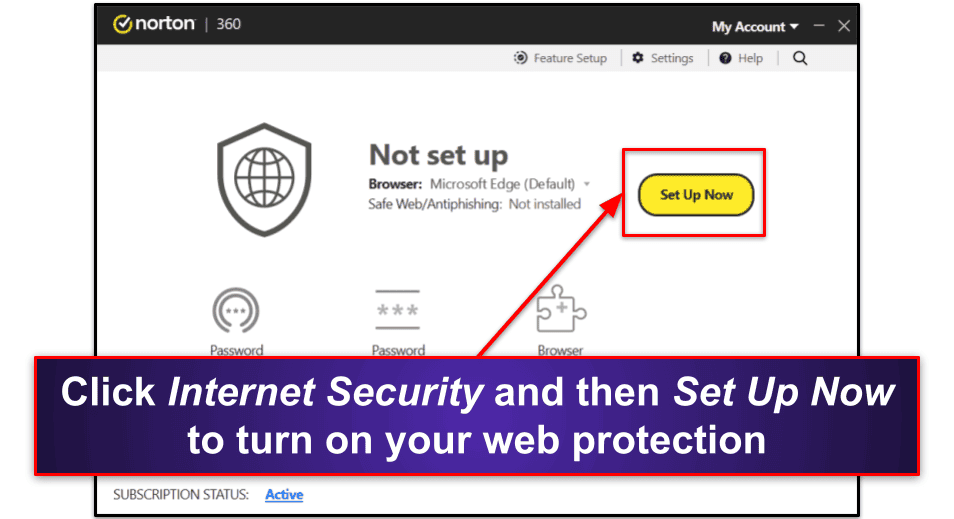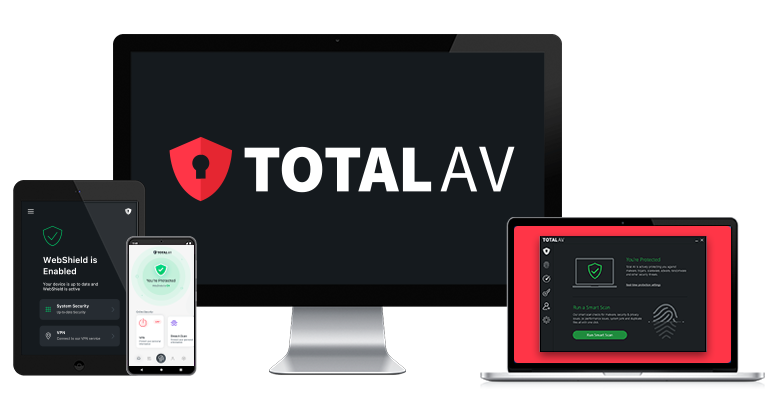
Tyler Cross
Updated on: January 4, 2024
Short on time? Here’s how to quickly check if a file is safe to download:
- Install reliable antivirus software. Choose a top antivirus like Norton, so you get every feature you need to stay safe, plus a flawless malware scanner.
- Run an antivirus scan. Run a custom scan on the file you want examined, or a full scan if you think the infection has spread. This will tell you if the file contains malware and help you remove it.
- Turn on real-time protection. Real-time protection blocks threats before they’re executed, so they can’t infect the rest of your device. Having real-time protection is vital to avoid malware taking root in your files.
- Turn on web protection. Most unsafe files come from shady websites, phishing scams, and suspicious links. Web protection prevents you from going into these fraudulent websites and filters phishing scams automatically — so you never accidentally click one.
- Follow tips and tricks for online safety. These are basic but important. Check the website’s domain to make sure it’s official, don’t click on links unless you’re completely sure the link is safe, and don’t open files from an email sender that you don’t recognize.
Before you download a file, ask yourself if you’ve checked whether it’s infected with malware. Downloading a file that you haven’t checked can easily wind up with you accidentally downloading malware onto your device, resulting in it draining your resources, spying on you, or helping hackers take full control of your network.
Fortunately, there are a lot of tell-tale signs that a file has an infection, as well as tools you can use to check a file and stay safe in the future. On top of basic tips, like never downloading a file from a suspicious website, a good antivirus will also keep you safe.
Norton is my top antivirus for checking if a file is infected in 2024. In addition to a flawless malware scanner, its real-time protection works great alongside its web protection to prevent you from downloading infected files in the first place.
How to Check if a File Has a Virus Before Downloading It (Step-By-Step Guide)
It’s actually pretty easy to check if a file is malicious. On top of some common safety practices that you should always follow, installing a good antivirus is important. I’ll be using Norton as my example — but the same steps and rules apply regardless of antivirus. That said, the specifics on how to run a scan or turn on features will vary.
Step 1. Install Reliable Antivirus Software
The first line of defense against cyber threats is having a reputable antivirus. Norton’s diverse range of protection tools and its robust threat-detection capabilities have earned its spot as my favorite antivirus in 2024. I’ll mostly be giving instructions on using Norton in this guide.
To install Norton, head to the website, choose your preferred plan, and purchase it. Click the link to download, and when the download is complete, open it from your file manager. The installation wizard will then walk you through the process of setting Norton up, though you’ll have to accept a few prompts and customize your settings.
Make sure Norton’s updated to the newest security patch, so you’re not vulnerable. It should do this automatically, but you can also go to the Device Security tab, use the dropdown menu, and click on the Live Update button. Norton will update itself if there are any pending updates.
Step 2. Run an Antivirus Scan
Once you’ve set up your antivirus software, it’s time to scan the suspicious file. Each premium antivirus software on my list allows you to run a quick scan, a full scan, or a custom scan of individual files. Opt for the third option. Click File Scan (or a similar alternative) and navigate to the file you’re concerned about. Finally, hit the Scan button. (Note: You can also right-click on the file and scan it using your antivirus software that way).
If you’ve already opened the file outside of your antivirus, you may have a bigger malware infection. In these cases, you need to execute a full scan by selecting the Full Scan option. It might take over an hour, as every single file on your device will undergo a thorough malware check, but it’s important you run the scan until the very end.
Whichever antivirus you choose will quarantine damaged files and let you remove them (or whitelist them in the rare situations where it flags a file you want to keep).
Step 3. Turn on Real-Time Protection
Real-time protection will defend you against malware before it can activate. While it’s on by default in most antiviruses, it’s always worth checking. Open up Device Security (or a similar alternative in your chosen antivirus), then click on the drop-down menu for Security. Afterward, just click the Advanced tab, and you’ll see whether Auto-Protect is turned on or off. If it’s off, just toggle it back to “On” to ensure you’re getting the real-time protection you paid for.
Step 4. Turn on Web Protection
Web protection allows you to avoid phishing scams and stops you from visiting unsafe websites — so it’s important to ensure you’re using it while online. A lot of threats mask themselves as legitimate companies or offers, so without good web protection, you’re at the mercy of the website you’re visiting.
To turn on web protection, go to Device Security (or a similar alternative in your chosen antivirus) and then click on the Internet Security tab. If web protection isn’t turned on already, click on Set Up Now if you’re using Norton and install the Norton Safe Web extension. You’ll have to follow a few prompts, but afterward, your browsers will be using Norton’s advanced security features to protect you while you browse the web.
Step 5. Follow Tips and Tricks for Online Safety
You can filter through most online dangers by following practical safety advice. For starters, it’s wise to refrain from opening suspicious files. If you can’t identify the source of a file or something about it just doesn’t feel right, it’s better to steer clear to avoid accidentally downloading malware.
Infrequently-downloaded files are considered very risky — If you can, check for how many other users have downloaded a file, its upload date, and any reviews it has, so you can get an idea of whether it’s a popular file or not. Look to see if the file size matches up with what you’d expect from a similar download, too — a bulky PDF file or particularly small video file may be malware in disguise.
The same rule applies to links, especially those embedded in emails, instant messages, or social media posts from people you don’t know. Clicking on them could lead you straight to a malicious site or cause an immediate malware download. Always verify the source of any emails you receive and don’t trust spam messages with links from people you don’t know.
Criminals often use social engineering tactics like masquerading as a legitimate website or vendor — that’s why it’s important to always check a company’s domain (even a real-looking one) to make sure the URL matches up with the official website’s URL. You should also ensure the URL is verified with SSL (meaning it says HTTPS, not HTTP).
Remember the timeless advice: if it’s too good to be true, it probably is. A prime example is the common “job scam,” where bad actors will use a high-paying position to trick people into downloading a file containing malware or giving the hackers personal information.
3 Best Antiviruses for Protecting Against Unsafe Downloads in 2024
Quick summary of the best antiviruses for protecting against unsafe downloads:
- 🥇 1. Norton — Best antivirus for checking infected files in 2024.
- 🥈 2. Bitdefender — Feature-rich antivirus that doesn’t tax your system.
- 🥉 3. TotalAV — Easiest antivirus to use in 2024.
🥇1. Norton — Best Antivirus for Checking Infected Files In 2024
Norton 360 is easily my favorite antivirus for removing infected files in 2024. It uses a massive database of known malware alongside artificial intelligence, making it capable of removing even the most advanced malware. During tests, it scored a perfect 100% malware removal rate, outperforming built-in antiviruses and most standalone competitors.
Norton 360‘s wide array of additional features includes:
- Secure firewall.
- Ransomware protection.
- Password manager.
- Webcam protection.
- VPN (with unlimited data).
- Dark web monitoring.
- Cloud storage.
- And much more…
Norton’s web protection shines in its proactive defense against various online threats. It effectively blocks malicious downloads and warns you about unsafe websites before you visit them. It also provides strong anti-phishing defenses, which shield you from deceptive sites that try to steal your personal information — ensuring a safer browsing experience.
Norton’s VPN is one of my favorite antivirus-bundled VPNs. Having a good VPN means that hackers won’t be able to read or intercept your data. What sets Norton’s apart from most antivirus-bundled VPNs is that you get unlimited data on all its 360 plans (in contrast, Bitdefender comes with harsh data limits on all but its top-tier plan).
The Smart Firewall included in Norton’s suite goes beyond what a typical firewall offers. It doesn’t just block unauthorized network access but also monitors both incoming and outgoing traffic. It gives you ARP and DNS spoofing protection, SSL man-in-the-middle attack detection, and port access detection. Plus, it’s highly customizable, letting you set rules for each application.
Norton’s dark web monitoring is simply the best on the market. Norton scours the deepest, darkest corners of the internet where personal information is bought and sold. If your data is found anywhere, Norton promptly alerts you, enabling you to take necessary actions to protect your identity.
Norton delivers great value with its range of packages. The entry-level AntiVirus Plus plan ($19.99 / year*) includes real-time malware protection, a firewall, and some other basic features. My favorite plan, Norton 360 Deluxe ($49.99 / year*), covers 5 devices and includes the unlimited-data VPN, great parental controls, and most of Norton’s other features. Norton comes with a 7-day free trial in some countries and a generous 60-day money-back guarantee.
🥈2. Bitdefender — Feature-Rich Antivirus That Doesn’t Tax Your System
Bitdefender is renowned for its sophisticated antivirus engine, which uses a blend of a comprehensive malware database and machine learning to protect against infected files, regardless of the type of malware. Its effectiveness was proven in my tests, where it successfully detected and eliminated 100% of the malware samples I used.
Bitdefender’s cloud-based engine causes minimal system impact, even during full disk scans — a great advantage when examining your device for potential infections. It’s an excellent product for someone with a lower-end PC or phone.
Bitdefender offers advanced customization settings, too, allowing you to set scanning parameters for specific areas like scripts, network shares, boot sectors, or new/modified files. It’s this level of customization that elevates Bitdefender as a top choice for those dealing with potential file infections.
In addition to its powerful scanner, Bitdefender’s plentiful extra features include:
- Web protection.
- System optimizer.
- VPN (200 MB/daily).
- Parental controls.
- Password manager.
- Webcam protection.
- And much more…
The web protection tool successfully blocked every dangerous phishing site I tried. This feature is crucial to avoid being deceived into downloading infected files. In case something slips through, Bitdefender’s ransomware protection defends your important files against encryption during an attack, keeping them safe in the worst-case scenario.
The built-in VPN works great. It provides quick access to encrypted servers worldwide, adding an additional layer of protection while you’re using the internet, and it’s just as fast as some standalone VPNs. The mobile apps also offer a double-hop feature (routes your traffic through 2 servers instead of 1 for increased security). However, it doesn’t quite match up to Norton‘s VPN because it’s limited to just 200 MB of data per day on all but the Premium Security plan.
Bitdefender Antivirus Plus ($29.99 / year) covers essential features for 3 PCs, but my personal favorite plan, Bitdefender Total Security, offers coverage for up to 5 devices across all platforms for $49.99 / year. Bitdefender Premium Security encompasses all features (including an unrestricted VPN) for up to 10 devices, making it a worthwhile investment at $79.99 / year. All of Bitdefender’s plans come with a risk-free 30-day money-back guarantee, so you can try it out in confidence.
Read the full Bitdefender review
🥉3. TotalAV — Most Intuitive Antivirus In 2024
TotalAV stands out as an excellent option for less tech-savvy users who want to check their files. It’s remarkably user-friendly, with an intuitive interface that still has plenty of advanced features. So while it’s very suitable for beginners, expert users will find lots to appreciate as well.
When I tested it out, I was able to get TotalAV installed and working in a few minutes without any problems. The first full scan took about an hour and barely impacted my laptop’s performance. It was able to catch 99.6% of the malware samples I’d buried in various files, which is certainly better than most antiviruses (but falls ever-so-slightly short of Norton).
On top of its excellent malware scanner, TotalAV includes a robust toolset of extra features, like a VPN, web protection, real-time protection, an ad blocker, and more. I’ll start by saying that the biggest drawback is its lack of a firewall, which can open you up to network threats. Both Norton and Bitdefender offer excellent firewalls.
That said, TotalAV’s web protection worked great during my tests. It effectively blocks phishing attempts, preventing harmful websites from stealing your personal information. I like how customizable it is, allowing you to create exemptions, toggle automatic blocking for low-risk websites, and much more, all from an easy-to-navigate menu.
While I wish it had a firewall, TotalAV provides a lot of value. Its ease of use, robust features, and range of plans make it worth considering. The entry-level Antivirus Pro plan costs $19.00 / year and covers 3 devices, while the TotalAV Internet Security plan, my favorite, covers 5 devices for $39.00 / year. All plans come with a risk-free 30-day money-back guarantee.
What To Do If You’ve Downloaded a Malicious File
If you suspect you’ve downloaded a malicious file, don’t panic. Start by disconnecting your device from the internet to prevent the malware from spreading or communicating with its controller.
Next, you’ll want to run an antivirus program. While I’m using Norton as an example (because it’s my favorite antivirus in 2024), any of my favorites will work.
To start, launch the antivirus and run a thorough system scan. This allows it to assess every file in your system and compare them to its expansive database of known threats. If the antivirus detects any signs of malware (like irregularities), it will promptly alert you and quarantine the suspicious file, letting you choose whether you want to completely remove it from your device.
How Do Infected Files Get Onto Your Device?
Malicious files infiltrate your device through various techniques used by cybercriminals:
- Phishing scams. Emails disguised as coming from legitimate sources may contain malicious attachments. Scammers also often use social engineering tactics (like a free prize or lottery win) to incentivize you to download their files.
- Torrenting. Free or discounted content such as movies or games might contain hidden malware. Remember that even popular torrenting sites may contain malicious downloads. Here’s a list of our best VPNs for torrenting, just so you can stay safe if you are planning on torrenting.
- Third-party app stores. These platforms lack rigorous security checks, leading to the circulation of apps with embedded malware. Sometimes, the whole app store could be a sham. Make sure you only download apps from reliable sources like the Apple App Store or the Google Play Store.
- Drive-by downloads: Visiting infected websites can automatically trigger malware downloads. This is why good web protection like that offered by Norton and Bitdefender is so important while browsing.
- Exploitation of vulnerabilities. Outdated software can be manipulated to introduce malware, so it’s always a good idea to keep everything on your computer up-to-date. Many antivirus programs (including Bitdefender) have vulnerability scanners that can do this for you.
It’s important that you always double-check email attachments, update software regularly, and only download from trusted sources. Even with the best antiviruses, like Norton or Bitdefender, you still have to remain vigilant online (though they certainly help!).
What Can Happen if You Download an Infected File?
When you download an infected file, you unknowingly invite many threats onto your computer. For example, you might download a .exe file masked as harmless software, only to find it’s actually a virus wreaking havoc on your system. Be careful of PDFs, word documents, spreadsheets, image files, movies, games and mods, and more (between you and me, just be careful of every file).
Malicious files could be ransomware, locking up your data and demanding payment for its release. Office documents can carry macro viruses, resulting in data corruption or even covert surveillance of the whole organization!
Some files host trojans, opening backdoors for hackers to take control of your system. You might even become an unknowing participant in a botnet, with your device being used to launch attacks on other systems. Additionally, keyloggers could record your keystrokes, stealing sensitive information like passwords and credit card numbers.
Best Ways to Avoid Virus-Infected Downloads
There are a lot of ways to fall victim to online hackers, so staying safe online requires vigilance and a few key practices you have to remember:
- Use a reliable antivirus. Always keep a reliable antivirus like Norton installed and updated. It will actively scan and protect against dangerous downloads.
- Use a VPN: Use a VPN to encrypt your online activity and keep your privacy protected. While Norton and Bitdefender both come with good VPNs, there are quite a few great standalone ones.
- Verify a website’s domain before downloading. Download files only from trusted and verified sources. If unsure, do a quick bit of research about the website’s reputation and check its domain to make sure it’s the official version of the website. Remember that some deals are too good to be true and that a 90% sale on a misspelled Amazon domain probably isn’t real.
- Avoid unsolicited downloads. Do not download files from unsolicited emails or messages. Emails can be home to incredibly nasty threats.
- Remember updates and patches. Keep your OS and software updated. Regular patches often fix security vulnerabilities.
- Use a firewall. A good firewall can block malicious inbound and outbound traffic.
Frequently Asked Questions
What types of files can be infected?
Any type of file can be infected with malware, though some are more commonly targeted than others due to their ubiquitous nature and the fact they are often used to share information. These include PDFs, Word documents, Excel spreadsheets, and other data files. Unfortunately, even seemingly harmless image files or MP3s can harbor malware.
It’s crucial to consider the source of the file. Trusted sources are generally safe, but files from unknown or suspicious sources can pose a risk. Antivirus software like Norton scans all types of files, ensuring a thorough check irrespective of the file type.
What kinds of viruses are usually in infected files?
Infected files can contain a wide range of viruses, all beaten by a good antivirus like Norton. Common types of malware you’ll find in a bad file include:
- Trojans. They disguise themselves as legitimate software to trick you into downloading them.
- Worms. Replicate themselves so that they can take over your entire device or even network.
- Ransomware. Encrypts your data before hackers attempt to ransom it back to you.
- Spyware. Collects information about your activity, which is usually sold online or used for further malicious assaults.
- Adware. Displays unwanted ads against your consent, usually constantly popping up, slowing down your device, and acting as a gateway to further malware.
Can I download infected files on my phone?
Yes, unfortunately, mobile devices are not immune to malware. You can unwittingly download an infected file onto your phone, just like on a PC. This can occur when downloading attachments, apps from unofficial sources, or even through compromised Wi-Fi networks.
Both Android and iOS devices can fall victim to malware, which is why it’s important to have a reliable antivirus app on your phone too. Norton, for instance, offers mobile security that provides real-time protection against existing and emerging malware, including ransomware and viruses.
How do antiviruses get rid of malware?
Antivirus software employs several strategies to identify and eliminate malware. It relies on malware databases to recognize known threats but also uses heuristic analysis to detect new or modified malware strains. Once the antivirus detects a malicious file, it places the file in quarantine to prevent the spread of the malware.
The antivirus then attempts to clean the file by removing the malicious code. If this isn’t possible, the file may be deleted entirely to ensure the safety of the system. It’s also worth mentioning that you need real-time protection to stop the infected file from getting downloaded in the first place and web protection to block online phishing scams — Norton comes with both.









